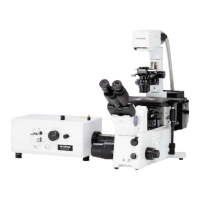APPLIED OPERATIONS/Merger/Extraction of Image Channels
IV.
OPERATION INSTRUCTIONS
IV .
2-334
Page
3. Display the image slice to start the range at the front using the <Display> button at
the top of the [Display] panel.
4. Click the <Set start position> button. (If the start position is not set, image No. 0
becomes the start image automatically.)
5. Display the image slice to end the range at the front using the <Display> button.
6. Click the <Set end position> button. (If the end position is not set, image No. n-1,
assuming the number of image slices is n, becomes the start image automatically.)
2-14-2 Merging Image Channels
For instance, when a specimen is imaged with two scans for 2-channel fluorescence
observation and 1-channel transmitted light observation, the transmitted light image can
be merged to the fluorescence images to create a 3-channel image. Note that the
display gradation of the images obtained by overlaying 3 channels may be poor than
original.
1. Open the two files to be used in creating a new image.
The image files used in overlay are subjected to the following
restrictions.
y
The sizes of the images in the two image files should be identical.
y
The number of data bits in the two image files should be identical.
(For example, it is not possible to overlay a Fluoview Multi Tiff file with
a Single TIF(S) 8-bit file.)
NOTE

